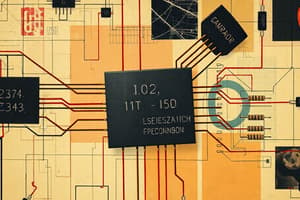Podcast
Questions and Answers
What happens to the Fermi level at temperatures above 0 K in intrinsic semiconductors?
What happens to the Fermi level at temperatures above 0 K in intrinsic semiconductors?
- It remains constant
- It drops below the valence band
- It falls below the conduction band
- It rises slightly upward (correct)
What factors influence the electrical conductivity in intrinsic semiconductors?
What factors influence the electrical conductivity in intrinsic semiconductors?
- Concentration of dopants and lattice defects
- Temperature and impurities
- Resistivity and external voltage
- Band gap energy and mobilities of carriers (correct)
How can the band gap energy of an intrinsic semiconductor be determined?
How can the band gap energy of an intrinsic semiconductor be determined?
- By plotting resistance vs. temperature
- By plotting 1/T against log resistance (correct)
- By calculating the average energy of electrons
- By measuring temperature only
What is the primary characteristic of N-type semiconductors?
What is the primary characteristic of N-type semiconductors?
Which of the following atoms can act as donor impurities in semiconductors?
Which of the following atoms can act as donor impurities in semiconductors?
Which relationship is observed between electrical conductivity and temperature in intrinsic semiconductors?
Which relationship is observed between electrical conductivity and temperature in intrinsic semiconductors?
What does the addition of acceptor impurities do to a semiconductor?
What does the addition of acceptor impurities do to a semiconductor?
What does the negative exponential dependence of electrical conductivity on band gap energy imply?
What does the negative exponential dependence of electrical conductivity on band gap energy imply?
What is the primary charge carrier in N-type semiconductors?
What is the primary charge carrier in N-type semiconductors?
Which type of atom serves as the acceptor impurity in P-type semiconductors?
Which type of atom serves as the acceptor impurity in P-type semiconductors?
What happens to electrons in P-type semiconductors when a small amount of energy is applied?
What happens to electrons in P-type semiconductors when a small amount of energy is applied?
In N-type semiconductors, the relationship between the number of free electrons and donor atoms is expressed as:
In N-type semiconductors, the relationship between the number of free electrons and donor atoms is expressed as:
What defines a semiconductor as N-type?
What defines a semiconductor as N-type?
In a P-type semiconductor, which statement is true regarding hole concentration?
In a P-type semiconductor, which statement is true regarding hole concentration?
The law of charge neutrality in semiconductors states that:
The law of charge neutrality in semiconductors states that:
Which element is NOT considered a trivalent acceptor impurity?
Which element is NOT considered a trivalent acceptor impurity?
What type of semiconductor is formed when trivalent impurities are doped in pure semiconducting material?
What type of semiconductor is formed when trivalent impurities are doped in pure semiconducting material?
What happens to the Fermi level of a P-Type semiconductor as the temperature increases?
What happens to the Fermi level of a P-Type semiconductor as the temperature increases?
Which impurities are typically used to create N-Type semiconductors?
Which impurities are typically used to create N-Type semiconductors?
What is the relationship between electron concentration in the conduction band and donor concentration in an N-Type semiconductor?
What is the relationship between electron concentration in the conduction band and donor concentration in an N-Type semiconductor?
In a P-type semiconductor, what occurs when the concentration of impurity atoms increases?
In a P-type semiconductor, what occurs when the concentration of impurity atoms increases?
What represents the energy needed for an electron to move from the valence band to the acceptor energy level in a P-Type semiconductor?
What represents the energy needed for an electron to move from the valence band to the acceptor energy level in a P-Type semiconductor?
At high temperatures, where does the Fermi level reach in N-type semiconductors?
At high temperatures, where does the Fermi level reach in N-type semiconductors?
Which statement correctly describes the behavior of a semiconductor at high temperature?
Which statement correctly describes the behavior of a semiconductor at high temperature?
What is the intrinsic carrier density formula calculated at 300 K based on the given electron and hole effective masses and band gap?
What is the intrinsic carrier density formula calculated at 300 K based on the given electron and hole effective masses and band gap?
At absolute zero, where does the Fermi level lie in a P-Type semiconductor?
At absolute zero, where does the Fermi level lie in a P-Type semiconductor?
What occurs as the temperature continues to rise after all donor atoms are ionized in an N-Type semiconductor?
What occurs as the temperature continues to rise after all donor atoms are ionized in an N-Type semiconductor?
What is the effect of increasing the mobility of electrons in a semiconductor?
What is the effect of increasing the mobility of electrons in a semiconductor?
How can the resistivity of a semiconductor be determined given the intrinsic carrier density and mobilities?
How can the resistivity of a semiconductor be determined given the intrinsic carrier density and mobilities?
What is the role of impurity atoms in a P-type semiconductor?
What is the role of impurity atoms in a P-type semiconductor?
What would be the effect on the Fermi level if the temperature of an N-type semiconductor is increased to 500 K?
What would be the effect on the Fermi level if the temperature of an N-type semiconductor is increased to 500 K?
Flashcards
Fermi Level at 0 Kelvin
Fermi Level at 0 Kelvin
At absolute zero (0 Kelvin), the Fermi level is positioned exactly halfway between the conduction band and the valence band in an intrinsic semiconductor.
Fermi Level at Non-Zero Kelvin
Fermi Level at Non-Zero Kelvin
When temperature is above absolute zero (T > 0 K), the Fermi level shifts slightly upwards due to the higher mobility of holes compared to electrons.
Intrinsic Semiconductor Conductivity
Intrinsic Semiconductor Conductivity
The electrical conductivity of a pure semiconductor is determined by the exponential relationship between the band gap energy, the mobility of electrons and holes, and the temperature.
Determining Band Gap Energy
Determining Band Gap Energy
Signup and view all the flashcards
Extrinsic Semiconductor
Extrinsic Semiconductor
Signup and view all the flashcards
Donor Impurity
Donor Impurity
Signup and view all the flashcards
N-type Semiconductor
N-type Semiconductor
Signup and view all the flashcards
Acceptor Impurity
Acceptor Impurity
Signup and view all the flashcards
Donor Energy Level (ED)
Donor Energy Level (ED)
Signup and view all the flashcards
Acceptor Energy Level (EA)
Acceptor Energy Level (EA)
Signup and view all the flashcards
Charge Neutrality in Semiconductors
Charge Neutrality in Semiconductors
Signup and view all the flashcards
Law of Charge Neutrality in N-type Semiconductors
Law of Charge Neutrality in N-type Semiconductors
Signup and view all the flashcards
Acceptor Level (EA)
Acceptor Level (EA)
Signup and view all the flashcards
Fermi Level in P-Type Semiconductor at 0K
Fermi Level in P-Type Semiconductor at 0K
Signup and view all the flashcards
Donor Level (ED)
Donor Level (ED)
Signup and view all the flashcards
Fermi Level in N-Type Semiconductor at 0K
Fermi Level in N-Type Semiconductor at 0K
Signup and view all the flashcards
Ionization Energy
Ionization Energy
Signup and view all the flashcards
Intrinsic Behavior
Intrinsic Behavior
Signup and view all the flashcards
What is the Fermi Level?
What is the Fermi Level?
Signup and view all the flashcards
How does temperature affect Fermi Level?
How does temperature affect Fermi Level?
Signup and view all the flashcards
How does impurity concentration affect Fermi Level?
How does impurity concentration affect Fermi Level?
Signup and view all the flashcards
Intrinsic carrier concentration (ni)
Intrinsic carrier concentration (ni)
Signup and view all the flashcards
What is conductivity?
What is conductivity?
Signup and view all the flashcards
What factors influence conductivity?
What factors influence conductivity?
Signup and view all the flashcards
What is resistivity?
What is resistivity?
Signup and view all the flashcards
What is the Fermi Level at T = 300K?
What is the Fermi Level at T = 300K?
Signup and view all the flashcards
Study Notes
Electrical Conductivity in Intrinsic Semiconductors
- At 0 K, the Fermi level is exactly midway between the conduction and valence bands.
- At temperatures above 0 K, the Fermi level rises slightly, as me > mh.
Expression for Electrical Conductivity
- The general expression for electrical conductivity (σ) is ηeμ.
- The intrinsic electrical conductivity (σi) is given by σi = nie(μe + μh), where:
- ni is the intrinsic carrier concentration.
- μe is the electron mobility.
- μh is the hole mobility.
Dependence on Band Gap and Mobilities
- Electrical conductivity depends on the band gap energy (Eg) between the valence and conduction bands, and the mobilities of electrons and holes.
- The mobilities are determined by the interaction of electrons with lattice vibrations (phonons).
Logarithmic Variation of Conductivity with Temperature
- The electrical conductivity varies exponentially with reciprocal temperature (1/T).
- This means conductivity increases as temperature rises.
- The relationship is expressed logarithmically as logσi = logC - (Eg/2KBT).
- Where C is a constant.
- kB is the Boltzmann constant.
Studying That Suits You
Use AI to generate personalized quizzes and flashcards to suit your learning preferences.
Related Documents
Description
This quiz explores the principles of electrical conductivity in intrinsic semiconductors, including the Fermi level behavior at different temperatures and the general expression for conductivity. It also examines the role of band gap energy and carrier mobilities in determining electrical conductivity. Test your understanding of these fundamental concepts!




